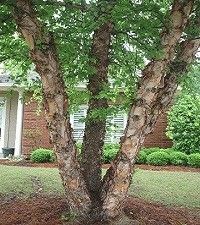Maryland DNR Recommended Tree
River birch, a deciduous tree, is a coastal native favorite because of the exfoliating bark that flakes off to reveal shades of tan and cinnamon beneath. The base of the tree is often divided into multiple slender trunks. Male and female catkins appear in Spring, followed by fruit composed of numerous tiny winged seeds packed betwen the catkin bracts. Leaves turn yellow in Fall. It grows to 80–100' with a trunk 20–60' in diameter. Plant in full sun to part shade in areas with medium to wet soil moisture.
River birch is native to the eastern United States from New Hampshire south to northern Florida. It is one of the few heat-tolerant birches in a family of mostly cold-weather trees, commonly occurring in floodplains and swamps. Many waterfowl use the cover for nesting sites, while the ruffed grouse and wild turkey use the seeds as a food source. Redpolls and pine siskins use the catkins. Deer have been known to graze on saplings or reachable branches. River birch is the host plant for over 15 moth species, including the bird dagger moth and bordelon's peridea moth.
BONAP Native Range Map (bright green indicates county native, dark green indicates state native)


